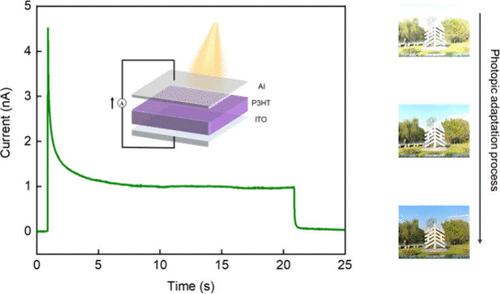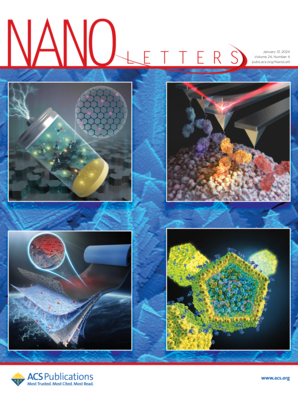A Self-Powered Organic Vision Sensor Array for Photopic Adaptation
IF 9.6
1区 材料科学
Q1 CHEMISTRY, MULTIDISCIPLINARY
引用次数: 0
Abstract
With the rapid development of artificial intelligence, it is essential to develop a bionic vision sensor that boasts low power consumption, self-adaptability, and broadband sensing for efficient image preprocessing. We employed an organic p-type semiconductor, poly(3-hexylthiophene-2,5-diyl) (P3HT), in conjunction with an Al electrode to engineer a Schottky junction. This design leverages the photogating effect due to the charge trapping by defects at the P3HT/Al interface, endowing this self-powered, two-terminal device with photopic adaptability. The 1.9 eV bandgap of P3HT enables substantial light absorption within the visible spectrum, yielding a significant photocurrent. By assembling 50 photoelectric sensors into a 10 × 5 array, we successfully demonstrated an image formation process that emulates photopic adaptation, specifically in recognizing letters. This easily fabricated, self-powered retinomorphic photoelectric device has great potential to mimic retinal structures, thereby heralding a new frontier in visual sensory devices.

求助全文
约1分钟内获得全文
求助全文
来源期刊

Nano Letters
工程技术-材料科学:综合
CiteScore
16.80
自引率
2.80%
发文量
1182
审稿时长
1.4 months
期刊介绍:
Nano Letters serves as a dynamic platform for promptly disseminating original results in fundamental, applied, and emerging research across all facets of nanoscience and nanotechnology. A pivotal criterion for inclusion within Nano Letters is the convergence of at least two different areas or disciplines, ensuring a rich interdisciplinary scope. The journal is dedicated to fostering exploration in diverse areas, including:
- Experimental and theoretical findings on physical, chemical, and biological phenomena at the nanoscale
- Synthesis, characterization, and processing of organic, inorganic, polymer, and hybrid nanomaterials through physical, chemical, and biological methodologies
- Modeling and simulation of synthetic, assembly, and interaction processes
- Realization of integrated nanostructures and nano-engineered devices exhibiting advanced performance
- Applications of nanoscale materials in living and environmental systems
Nano Letters is committed to advancing and showcasing groundbreaking research that intersects various domains, fostering innovation and collaboration in the ever-evolving field of nanoscience and nanotechnology.
 求助内容:
求助内容: 应助结果提醒方式:
应助结果提醒方式:


